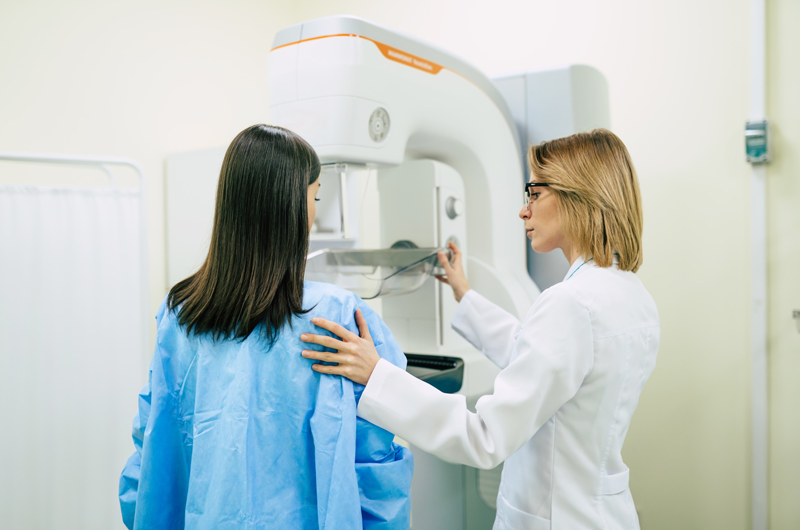Breast cancer is the second leading cause of cancer death among American women. Reports from the American Cancer Society (ACS) (2015 statistics),point out that about 231,840 new cases of breast cancer will be diagnosed in women and about 40,290 women will die from this disease. It is estimated that about 1 in 8 (12%) women in the US are diagnosed with non-invasive breast cancer during their lifetime.
As per recommendations from the American Cancer Society, women should undergo breast cancer screening tests at an early age (right from their early 50s or sooner) as these tests help to identify this condition early enough before the patients start to show symptoms. Oncologists recommend several billable (CPT and HCPCS Codes for review for medical billing and coding are given below) screening techniques for women such as mammograms, clinical breast exam, breast-self exam, molecular breast imaging, digital tomosynthesis and even MRI screening. However, a new study shows that regular mammogram screening for breast cancer might be causing “widespread over diagnosis” with some women being treated for tumors that would not have caused sickness or death.
The study published in the Journal JAMA Internal Medicine (July 6, 2015 issue) examined the relationship between screening rates in the US communities and cancer deaths and tumor sizes.
As part of the study, researchers analyzed medical data for 16 million women aged 40 years and older who lived in 547 countries reporting to Surveillance, Epidemiology and End Results cancer registries in 2000. (The SEER registries are maintained by the U.S. National Cancer Institute).
Out of these, 53,207 women were diagnosed with breast cancer in 2000 and were followed up for a decade. Researchers performed a county-by-county comparison of mammogram rates against both the incidence of breast cancer in 2000 and deaths from this disease during the follow-up period. They specifically analyzed the percentage of women aged 40 years and above who had a mammogram in the past two years.
It was found that when breast cancer screening increased by 10 percent, physicians diagnosed cancer 16 percent more often overall. In addition, there was a 25 percent increase in the diagnosis of small tumors which measured 2 centimeters or smaller. Researchers also found that the increased screening did not lead to a significant change in death rate. Many previous studies have claimed that mammography results in significant reduction in breast cancer death rates for women aged 40 and older. However, the new findings signify that some women may be able to have less frequent mammograms.
Mammogram is a specific type of imaging that uses X-ray system to produce images of the inner breast tissue. With this technique, the normal and abnormal structures within the breasts are visualized. This makes it possible to detect small tumors that cannot be felt. It also helps to find micro calcifications (tiny deposits of calcium) that sometimes indicate the presence of breast cancer.
Physicians should document their reasoning for study, diagnosis and the preventive measures they perform correctly so that medical coders can assign appropriate codes and ensure proper reimbursements. Since even minor coding mistakes may result in the denial of claims, it is beneficial to work with a medical billing and coding company that offers the service of AAPC-certified coders and billers. For Review the procedure codes for mammogram include:
CPT Codes
- 77051 Computer-aided detection (computer algorithm analysis of digital image data for lesion detection) with further review for interpretation, with or without digitization of film radiographic images; diagnostic mammography
- 77052 Computer-aided detection (computer algorithm analysis of digital image data for lesion detection) with further review for interpretation, with or without digitization of film radiographic images; screening mammography
- 77055 Mammography; unilateral
- 77056 Mammography; bilateral
- 77057 Screening mammography, bilateral
HCPCS Codes
- G0202 Screening mammography, producing direct digital image, bilateral, all views
- G0204 Diagnostic mammography, producing direct digital image, bilateral, all views
- G0206 Diagnostic mammography, producing direct digital image, unilateral, all views
However, researchers point out that the above study findings should not encourage women to think that mammograms are either unnecessary or potentially harmful. Mammograms are still important, but physicians need to figure out which women really need mammograms and on which schedule.
Physicians need to discuss with their patients what mammography can and can’t accomplish before they undergo this screening procedure. The study also highlights the need for further research that will help physicians better sort out dangerous breast cancers from other breast tumors that may not require immediate treatment.




